Texas School Business Sixteenth Annual BRAGGING RIGHTS 2022-2023 Splendora ISD Aransas County ISD Birdville ISD Cotton Center ISD East Bernard ISD Friendswood ISD Groesbeck ISD Hutto ISD Irving ISD Northside ISD Pewitt CISD Socorro ISD 12 School Districts with Outstanding Programs
At School Outfitters, our project experts are ready to help your school make the most of its ESSER funds.
We’ll work closely with you to outfit school spaces that address the unique needs of your students and staff.

Whether you’d like to outfit a tranquility room to ease student anxiety, remodel a library to accommodate tutoring sessions or upgrade a teacher’s lounge for your staff, our experts have the furniture you need.
And with our exclusive, ready-to-ship inventory, you can be sure your ESSER funds project will get done on time and on budget.
School Outfitters is an authorized Texas state vendor on these contracts:
• BuyBoard
• TIPS
• GoodBuy
• ESC contracts (multiple)
Ready-to-ship inventory
Find the products you need, in stock and ready to ship.
Multi-phase
Work with experts who know how to manage large, complex projects. Custom
project management
purchase programs
custom pricing, products and services
installation
installers
customized
Improve your school with ESSER funds We’ll partner with you for custom furniture solutions What makes us different 1-800-260-2776 | www.SchoolOutfitters.com
• District contracts (multiple) space planning
Get
for your district. Hassle-free
Tap into our network of reliable
for
installation.
Objective-driven
Plan your spaces around your specific educational goals.
From the editor

Tremendous things are happening in Texas public education, and this magazine is proof of that. In this, our 16th annual special Bragging Rights issue, we highlight 12 pioneering programs in Texas public schools today.
From tiny, rural districts to mega-sized urban districts, there is so much innovation happening in our schools that it was tough to narrow down the 120 Bragging Rights submissions we received this year to just 12.
The 12 featured programs illustrate how our schools continue to look for ways to better serve students, whether it’s creating school culture routines or engaging students in learning that prepares them for careers in the maritime industry.
If you want to know more about any of the programs covered in this issue, don’t hesitate to reach out to your colleagues. They are all proud of the work they’ve done and eager to share their success stories with you. That’s the beauty of public education: We’re all in it together.
Texas School Business

 DACIA RIVERS Editorial Director
DACIA RIVERS Editorial Director
BRAGGING RIGHTS 2022-2023 Volume LXIX, Issue 7 406 East 11th Street Austin, Texas 78701 Phone: 512-477-6361 Fax: 512-482-8658 www.texasschoolbusiness.com
EDITORIAL DIRECTOR Dacia Rivers DESIGN Phaedra Strecher ADVERTISING SALES Jennifer Garrido TEXAS ASSOCIATION OF SCHOOL ADMINISTRATORS
EXECUTIVE DIRECTOR Kevin Brown DIRECTOR, COMMUNICATIONS & MARKETING Amy Francisco
Award-Winning Tools for World - Class Schools




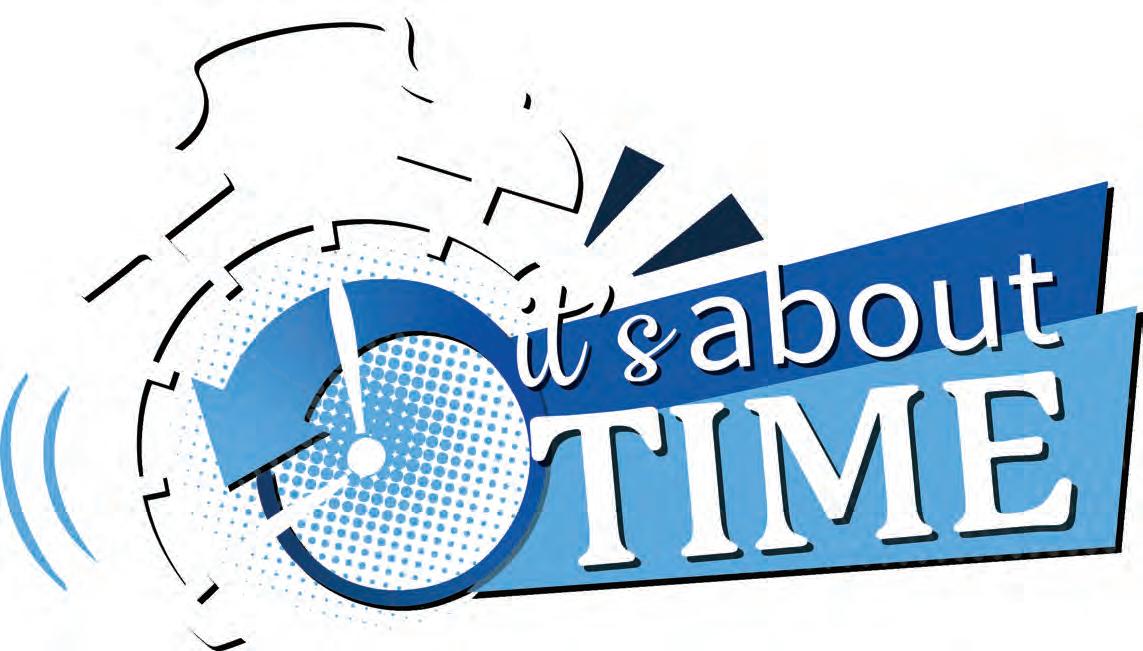
Splendora ISD Aransas County ISD Birdville ISD Cotton Center ISD East Bernard ISD Friendswood ISD Groesbeck ISD Hutto ISD Irving ISD Northside ISD Pewitt CISD Socorro ISD Sixteenth Annual BRAGGING RIGHTS 2022-2023 7 13 17 21 25 29 32 35 38 41 44 47 Visit texasschoolbusiness.com to download this issue to share and view the entire archive of Bragging Rights issues.



Count on HMH as your partner for STAAR Redesign practice! Houghton Mifflin Harcourt®, and HMH® are trademarks or registered trademarks of Houghton Mifflin Harcourt. All rights reserved. Printed in the U.S.A. 10/22 FSMB1681 Visit Booth 637 at the TASA Midwinter Conference and register to win a pair of AirPods! Contact HMH to learn more about our solutions for Texas.
ARANSAS COUNTY ISD
Aransas County prepares students for maritime careers
by Dacia Rivers
Some of the most on-demand jobs across the state right now are those that require specialized hands-on training. To meet this demand, high schools throughout Texas have ramped up their CTE programs, focusing on the unique skill sets most required in their respective communities. In Aransas County ISD, located on the Gulf coast, a new maritime science CTE program aims to prepare students for jobs in the area.
The program kicked off a couple of years ago when the local community, including local captains working in the maritime industry, approached the school district and the superintendent to see how they could partner with

ACISD to get graduates ready for the jobs they needed to fill.
Rhonda Mieth, principal of Rockport-Fulton High School, says the district found the perfect candidate to help create and run the maritime CTE program in Josh Nguyen, a retired Coast Guardsman who also worked as a boat captain following his retirement.
“We’re very fortunate that Josh is a RockportFulton High School graduate, and he was back in the area,” Mieth says. “This role was perfect for him. He’s got the knowledge and he’s got the desire to help students in the community.”
Nguyen spent a year working with the district to
Aransas County ISD
County:
7 BRAGGING RIGHTS 2022-2023 Texas School Business
▲ Students in Aransas County ISD’s maritime science program float on a barge they created in class.
Aransas ESC region: 2 Superintendent: Joshua Garcia 2020 enrollment: 2,965 Number of schools: 4
Texas phonics requirements have been updated. Has your instruction?
Magnetic Reading Foundations supports the newest Texas phonics curriculum requirements.
Magnetic Reading Foundations guides students from foundations to fluency by providing:
• A comprehensive foundational skills program
• 100% coverage of the Phonics TEKS
• Instruction rooted in the Science of Reading research, connecting to the Texas Reading Academies
See why Magnetic Reading Foundations is the best choice for Texas classrooms. Learn more at MagneticReading.com/Texas.

create the curriculum for the program. He also worked at the ACE after school program, building relationships with students so he could get them interested in maritime CTE and hopefully prerecruit them for the program.
“The first year has been very successful,” Mieth says. “We have more than 80 students signed up for the intro course. For our size school, those are phenomenal numbers.”
Currently in ninth grade, the first cohort of the maritime program has spent the first semester focused on safety, both in the water and in the workshop. The second semester, Nguyen says, is when things start to get fun.

“Once they have the safety side of things, we actually do everything they were taught to be safe about,” Nguyen says. “They’ll be in the shop and on the water, implementing those safety procedures and doing it all hands-on.”
Students enrolled in the program are working to build a barge, and in the spring they’ll learn more about working with lines and securing boats to cleats — an important first step.


“They’re going to be learning more about nautical terminology and what it would take to maneuver and run a ship,” Nguyen says.
During the course of the four-year program, students will move onto more advanced engineering classes and will have the option to become scuba certified. Nguyen says he is also working with local companies to secure internships for his maritime students.
“Ultimately, it would be awesome if we had paid internships for every student over 16,” Nguyen says. “I think it’s possible, it’s just a matter of time and work.”
The goal is that, at the end of the program, students will graduate with the skills and licenses needed to go into a career in the maritime industry, if they so choose.
9 BRAGGING RIGHTS 2022-2023 Texas School Business
▲ ACISD’s maritime tech program is a CTE program designed to prepare high school students with the skills and knowledge they would need to go into a career in the maritime industry.
10 BRAGGING RIGHTS 2022-2023 Texas School Business
— the
all-in-one customer experience and intelligence platform designed for K-12
helps school districts across the nation deliver superior customer service.
Let’s Talk
only
—
k12insight.com
Better
Better education.
Better experiences.
engagement.
“The maritime industry right now is growing so rapidly that labor can’t keep up,” Nguyen says. “When these guys graduate, they’ll have the skill set of a middle-skilled employee at a port, for example.”
The program’s industry connections will not only provide internships and potential careers for students, but also help to cover some of the costs of the program. Nguyen helped to create a nonprofit through the Texas Coastal Academy, which allowed him to more easily reach out to industry leaders and secure their support. He says getting that support has been relatively easy, with many seeing the potential benefits of the program.
“The community was already invested in this before I even got here,” Nguyen says.
Mieth adds that the ACISD Education Foundation has also been able to provide some grant funding to the program. The district recently became a recipient of a Jobs & Education for Texans (JET) Grant, and those funds will help the maritime program continue in the years ahead.


On the student side, interest in the program shows no sign of slowing. Nguyen says 32 students who are enrolled in the class
regularly come in early, stay after school, or come in on the weekends to work on projects — a ringing endorsement from any high school student. Mieth adds that no one has dropped the class so far yet, another sign that the program is a hit.
Parents of enrolled students are similarly involved — Nguyen held a “Friendsgiving” event for them last year, with an impressive 94% parent turnout.
Looking ahead, Nguyen is working with local industry partners to provide internship and cadet programs for his students. Mieth says some local organizations have reached out to invite the maritime students to come and visit their offices on field trips so they can see for themselves what it would be like to work in the field.
“When we have career days now, we have more interest because of the maritime presence that we have,” Mieth says. “It’s not only helping the maritime program, but it’s helping all of our students and bringing more industry into the school so we can show students all the options out there.”
Dacia Rivers is editorial director of Texas School Business.

11 BRAGGING RIGHTS 2022-2023 Texas School Business
▲ Demand for a maritime science CTE program came to ACISD from local maritime industry leaders looking to fill open positions.



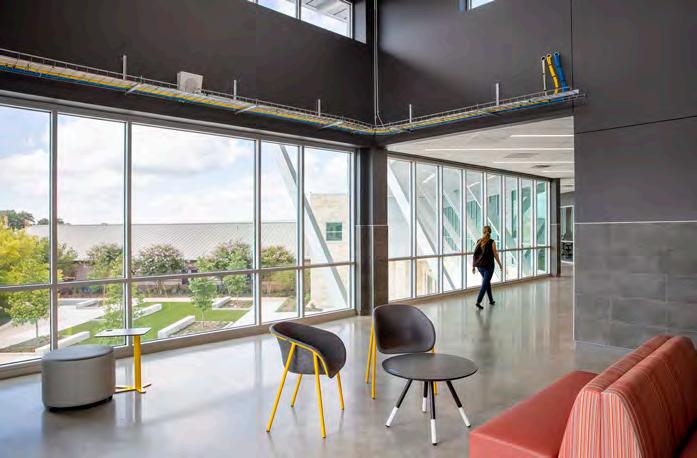
about creating great experiences.
Passionate
Top 10 PreK-12 Architecture Firms in the U.S. Building Design + Construction
At Corgan, the only standard for successful design is an inspired student. We are focused on creating outstanding learning experiences. architecture · interior design · corgan.com
BIRDVILLE ISD
Students’ talents blossom in Birdville
by Merri Rosenberg
The breathtaking arrangement of purple roses and sunflowers would be eyecatching at any florist. For subscribers to the BCTAL Blooms Arrangement of the Month, these student-created and produced designs are anticipated eagerly.
Dave Lambson, Birdville’s chief technology officer, who has been in the district for a decade, was one of the first to sign up when the program started three years ago.
“This is giving kids real-world experience,” says Lambson, who was thrilled when one of the students sent him an email the night before he received his first arrangement for the current school year. “They’re learning customer service and the business side, as well as personal skills and communication.”
That’s the point: professional preparation so students understand that there’s more to flowers than being able to make pretty bouquets.
The program’s teachers come from the industry. Students don’t only learn about the principles of floral design and practice those skills in the classroom. They’re also given a foundation in the economics of running a floral business, from the wholesale cost of flowers to the expenses of things such as green floral tape and foam, deliveries and how to market their business.
Amanda Williams, a floral industry professional for 11 years who owned her own shop for five, joined the district as a BCTAL Blooms teacher this year.
“We give them skills so they can be hirable,” such

13 BRAGGING RIGHTS 2022-2023 Texas School Business
▲ Dave Lambson, chief technology officer in Birdville ISD, poses with Birdville ISD BCTAL Blooms members while picking up a floral arrangement created by studeents.
Birdville ISD County: Tarrant ESC region: 11 Superintendent: Gayle Stinson 2020 enrollment: 23,503 Number of schools: 32
as using color for balance and contrast as well as working with wire and tape. “They work as a team to meet deadlines.”
A key lesson is how to price the arrangements they design.
“We’ll give them the wholesale cost,” Williams says. “This is how you make it up, and what they should sell the arrangement for. We expect them to be able to do it on their own.”
BCTAL Blooms is so professional, she says, a retired teacher from the district hired students in the program to handle the flowers for her daughter’s wedding
The BCTAL Blooms program is part of Birdville ISD, which has made a major commitment to Career and Technical Education. In 2009, the district, which serves about 23,000 students at 33 campuses, opened the Birdville Center of Technology and Advanced Learning (BCTAL), a state-of-the-art campus where there are no bells and its 1,800 students, drawn from the district’s four high schools, follow a schedule more like a college student’s than that of a typical high school day.
BCTAL Blooms, launched in 2017, is housed in the agricultural science pathway. Students at the BCTAL campus can also pursue automotive technology, business and marketing, construction, cosmetology, culinary arts, health sciences, legal and protective services and STEM, among other disciplines. The district, which is located about 30 miles northwest of Dallas, views its mission as preparing students for both college and careers.
“Our district has championed having a college-ready workforce and a future-ready workforce,” says Mark McCanlies, principal of Birdville High School. The BCTAL Blooms courses fit into this idea of a hands-on class on a hands-on campus.
Gayle Stinson, superintendent of Birdville ISD, adds: “It’s exciting to serve a district that offers students educational opportunities that equip them to enter directly into the workforce. Birdville ISD’s floral design program is one such course. The instructors have developed a program that is highly sought after by students. Moreover, it’s a program that has become a model for other school districts.”
The district funds about 25% of the program’s costs. BCTAL Blooms’ student-based enterprise income covers the rest.
The program’s popularity has soared since its launch five years ago, says Tyler McCoy, a BCTAL Blooms facilitator and a certified floral designer and Texas State Florist Association, who joined the district five years ago.

In 2018, there were 87 students in the program. Now there are more than 300 students enrolled in floral, horticulture and plant science classes, which are held in three classrooms at the BCTAL campus. There are currently nine sections of floral design, with three dedicated teachers for the program. Students can follow a sequence of intro to floral design and move on to advanced floral and floral practicum classes. Even students who don’t aspire to work in the industry can take floral design as an alternative to conventional art classes.
Those students who choose to go directly into the workforce are expected to earn appropriate certifications. Allison Vinson, CTE director in Birdville, says in 2021-22, 180 BCTAL Blooms students earned their Texas State Floral Association Knowledge-Based Certifications.
Those who earn the industry certification, she adds, “can hit the ground running” when they enter the field or pursue postsecondary education.
Cheryl Vaughan, president of the Texas State Floral Association agrees.
“Florists who hire students who have that Level 2 certification on their diploma know they have the basics, and can handle basic arrangements,” she says, adding that the program also gives students an idea of the opportunities in the profession, whether it’s through wholesale, retail, as growers, freelancers or even “educated consumers.”
As a former industry professional, McCoy explains, “We start with the principles and elements of design.” For the first level of certification, students are expected to know the vocabulary and be able to make a symmetrical triangle arrangement (like you’d see in a hotel entryway), and a one-rose boutonniere. For the more advanced certifications, students are expected to present a portfolio of advanced floral designs as well as be able to solve design problems. Advanced students build their own businesses as a final project, including the layout of a floral shop, a logo, advertisements, and a plan for covering expenses such as rent.
BCTAL Blooms students do one hands-on floral project every three weeks.
“You learn flowers by doing,” says McCoy.
Other opportunities for practical work, besides the Arrangement of the Month, include internships at a local florist and competing at stock shows around Texas, such as the Fort Worth Livestock Show, Tarrant County Jr. Livestock Show and the Houston Livestock Show and Rodeo, among others.
14 BRAGGING RIGHTS 2022-2023 Texas School Business
▲ BCTAL Blooms is a floral-design CTE program for high school students in Birdville ISD.
Students also compete in the Battle of the Blooms, which attracts colleges and universities as well as other high schools. Last year, 17 schools took part in The Battle of the Blooms, with 350 students competing in 54 teams of two to three students.
Vaughan says the Battle of the Blooms gives students a sense of “designing under pressure. That’s a skill set, working under a time crunch and having time management. When you have a funeral to get out, you have to do it.”
“From the first day, we push that we are BCTAL Blooms, and build teamwork,” says McCoy. “We go into marketing and the impact of branding. We give them T-shirts,” which students are encouraged to wear at these events and competitions, as well as on Fridays, for Floral Fridays.
For Valentine’s Day, the Blooms students sell single stem roses at each of the three high school campuses. And for the district’s annual plant sale, students “are involved in every literal step of the growing to selling process,” says McCoy. The students grow around 25,000 plants for the plant sale, which is attended by about 1,200 community members. Although it’s billed as a two-day event, it usually sells out the first day.
What’s also distinctive about the overall BCTAL program, including Blooms, is that it attracts a diverse group of students. There are class valedictorians and students in special education. Student athletes, including volleyball and football players, also enroll. In fact, 30% of the students enrolled in the floral Blooms program are boys.
“You get a wide range of students in the floral design class,” says McCanlies. “If this piques a student’s interest in a future career, then we’ve done our job.”
As Omega/special education teacher Jordan Trammell says, the Blooms’ teachers “are accommodating to everyone and everything.
The students grow around 25,000 plants for the plant sale, which is attended by about 1,200 community members. Although it’s billed as a two-day event, it usually sells out the first day.
The social aspect encourages [the students] to be a part of the group. It’s very reassuring to these parents who have been hearing what their kids can’t do, and now what they can do. Their children can contribute to society like anyone else.”
It’s especially ego boosting when special education students win prizes for their floral designs and sell them, and they realize they can compete.

Consider how Blooms has changed the trajectory for special education student Logan Housman, a senior in the program.
“There’s kids like Logan that never really get included,” says Daniel Housman, Logan’s father. “This is like Logan’s Friday night lights. When he got into this program, he talked about it so much. This is something he studies. He loves it so much. We’ve observed how much he’s learned in BCTAL Blooms. He gets to see the whole nine yards, and it’s been very beneficial for him.”
Merri Rosenberg is a freelance writer specializing in educational issues, based in Westchester County, New York. merri.rosenberg@gmail.com
15 BRAGGING RIGHTS 2022-2023 Texas School Business
▲ BCTAL Blooms students created an arrangement of the month for subscribers, in addition to competing in the annual Battle of the Blooms.
COUNSELORS REINFORCING EXCELLENCE FOR STUDENTS IN TEXAS
CREST Awards, sponsored by the Texas School Counselor Association (TSCA), recognize schools across Texas that demonstrate an ongoing commitment to building effective school counseling programs and strong campus teams.




These campuses implement the four components of the Texas Model for Comprehensive School Counseling Programs, 5th edition as required by the Texas Education Code and endorsed by TEA. Alief

TSCA is a division of the Texas Counseling Association. www.txca.org/tsca/

ISD Allen ISD Aransas Pass ISD Argyle
Aubrey ISD Austin ISD Boerne ISD Brownwood ISD Columbus ISD Corpus Christi ISD Del Valle ISD Denton ISD Dripping
ISD Dumas
Fort Bend
George
Georgetown
Granbury ISD Humble ISD Lamar Consolidated ISD Leander ISD Lewisville ISD Little Elm ISD McAllen ISD McKinney
Mesquite
North East
Northside
Pasadena
Rockdale
Rockwall
San
San
Tomball
Congratulations to the 2022 CREST Winning Districts View the Roster of Award-Winning Campuses www.txca.org/docs/2022_CREST_Award_Winners.pdf
ISD
Springs
ISD
ISD
I. Sanchez
ISD
ISD
ISD
ISD
ISD
ISD
ISD
ISD
Angelo ISD
Augustine ISD
ISD
CREST is a continuous improvement tool that professional school counselors use to demonstrate effective program design, implementation, and a commitment to achieving results that boost student success, engage the campus community, and promote wellness and safety for their schools.
Classroom Guidance Responsive Services Individual Planning System Support
COTTON CENTER ISD
School culture routines maximize learning time
by Dacia Rivers
Leading a tiny district presents its own unique situations, but in many ways, the small and the large aren’t all that different.
In Cotton Center ISD, a 99-student district north of Lubbock, Superintendent Ryan Bobo says creating school culture routines has helped streamline learning – and it’s something he says can benefit districts of any size.
The district is involved in the Texas Instructional Leadership (TIL) program, a system that works with districts to provide leadership training and help improve outcomes. As the first step of the program, CCISD began implementing the school culture routines in 2021.
Bobo says the district already had some of these
routines in place, but the partnership helped them to refine the process.
“Some of these routines, some teachers were doing it, but not all, so we weren’t all on the same page,” he says. “We decided to make it all into one unit.”
The purpose of these routines is to provide ample, useful classroom time to students without distractions. The first routine focuses on hallway behavior. Students are taught to walk on the right side of the halls, treating them just like a highway, to avoid slowdowns and other incidents.
For the younger students, the district uses the acronym KYHFTY, to remind the kids to Keep Your Hands and Feet to Yourselves. Teachers remind students to walk down the halls with a

17 BRAGGING RIGHTS 2022-2023 Texas School Business
▲ Signs around Cotton Center ISD serve as reminders for students as part of the district’s school culture routines.
Cotton Center ISD County: Hale ESC region: 17 Superintendent: Ryan Bobo 2020 enrollment: 99 Number of schools: 1
bubble in their mouths and their ducktails in place, meaning with their mouths closed and hands held behind their backs.
“The whole objective was, if we could get them out of the hallways, we’d have more time in class,” Bobo says. “We’d have more opportunities to teach them in the classroom.”
Teachers give frequent reminders to students, rather than using punishments if they forget the routines. Bobo says it’s important that the routines aren’t seen as punitive or negative. The goal is for students to get used to the routines so that they become second nature.
Beyond the hallways, the routines continue into the classrooms. At the door, elementary students can choose how they will be greeted by their teacher each day: with a hug, handshake, pat on the back, or another greeting of their choice.
“It’s a happy routine that gets them going for the course of the day,” Bobo says.
Once inside the classroom, each student follows a First Five routine, where they do the things they need to be ready for class, such as pulling out their laptops and logging into the system. This way, when class begins, the teacher can jump right into teaching, without waiting for students to prepare.
At the end of the class period, the students follow a similar Final Five, which usually includes some sort of exit ticket so teachers can make sure they understood the day’s lesson. The routines
also specify how to handle dismissal so that all students exit the building at the same time and get exactly where they need to go. At the upper grade levels, students are expected to stick to the “ELK Way” (CCISD’s mascot is the elk), with ELK standing for excellence, leadership and knowledge.


“We try to use that language with the older kids to start building their leadership skills, so they can do the best they can all the time,” says Paige Bobo, head of educational guidance in the district.
Ryan Bobo says that initially, buy-in from the older students was a bit of a challenge.
“We had to explain to them why we were doing it, and that was to make sure we utilized the time they had in class,” he says. “It became routine, and now they don’t even think about it. They do it.”
While the district already had a good base culture, Bobo says that the addition of these routines has helped the school run like a well-oiled machine.
“Our elementary school looks great,” he says. “It’s like clockwork. There’s no wasted time in the day.”
Teachers in CCISD are big fans of the new routines, Bobo says. After the first year, there was a 100% retention rate among staff.
“I think it helped some of our younger teachers and some of our
18 BRAGGING RIGHTS 2022-2023 Texas School Business
▲ Students in Cotton Center ISD are reminded to keep their hands and feet to themselves and to follow the “Elk Way.”
more veteran teachers as well, to make sure they had something at the beginning and end of a class, instead of just opening up the class to start. It helped them stay organized within their class.”

This year, CCISD is implementing the second part of the TIL program, which is a focus on data-driven instruction. This step includes taking a deep look at test scores and other data to make sure the district is serving students in the areas where they need it most. If the data finds that a student is lacking in any area, CCISD can then step in to serve them on an individual basis if needed.
Bobo has seen the changes school culture routines have made in his district, and while he recommends the program to others, he stresses that doing so successfully requires staying on top of things and offering frequent reminders.
“A lot of times these programs are a flash in the pan, but this one, you have to stay on top of it. You have to keep reminders, especially after gaps like spring and summer breaks. You have to go back and revisit these things for this to really set in and work.”
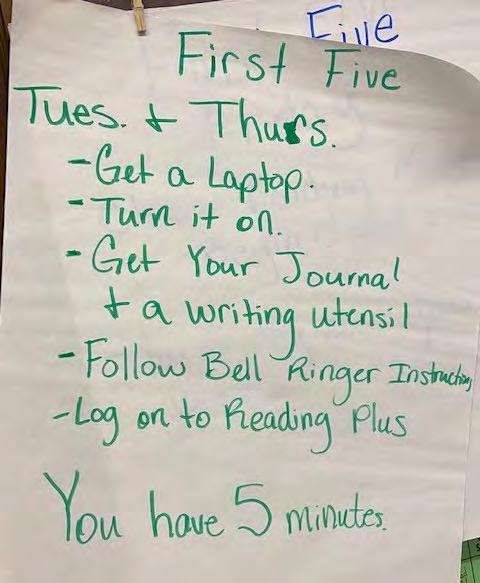
19 BRAGGING RIGHTS 2022-2023 Texas School Business
Dacia Rivers is editorial director of Texas School Business.
While the district already had a good base culture, Bobo says that the addition of these routines has helped the school run like a well-oiled machine.
▲ Teachers in Cotton Center ISD set a “First Five” routines to maximine instructional time.

EAST BERNARD ISD
Summer learning is squishy, messy fun in East Bernard ISD
 by Leila Kalmbach
by Leila Kalmbach
If you pass by an elementary school over the summer, you might not be surprised to see students participating in sports camps or required summer school classes. What you probably wouldn’t expect is to see young kids digging for worms, learning to make pancakes, or dissecting animal specimens.
Yet that’s exactly how 136 pre-K through fourth grade students spent eight days this past June at East Bernard ISD’s Brahma Brain Camp, which took place at the district’s elementary school campus. The summer enrichment program was
a hands-on, interactive experience designed to minimize summer learning loss and engage kids in fun learning activities outside the normal school curriculum.
“I think like all schools, we were seeing kind of a drop in student performance academically, and really an increase in student apathy after coming off of COVID,” says Superintendent Courtney Hudgins of the idea for Brain Camp.
Noting that the district offered a variety of sportsrelated and outdoor camps but nothing fun for the
Bernard ISD
21 BRAGGING RIGHTS 2022-2023 Texas School Business
▲ Students in East Bernard ISD participate in Brahma Brain Camp, a summer program designed to combat learning loss.
County: Wharton ESC region: 3 Superintendent: Courtney Hudgins 2020 enrollment: 937 Number of schools: 3
East
academic side, Hudgins came up with the concept for camp, and four district teachers ran with it. Linda Vincek, a seventh grade English and eighth grade reading teacher; Lauren Heckmann (then Haedge), the district’s journalism adviser; Hallye Henry, a third grade teacher in math, science and social studies; and Cassidy Wilkerson, a third grade teacher in reading and language arts, took on director roles to get the camp off the ground. During camp itself, Vincek and Heckmann acted as active daily directors, while Henry and Wilkerson taught camp classes.
Each day, camp began at 9 a.m. and ended at 2 p.m. Students were divided into groups of younger (pre-K through first grade) and older (second through fourth grade) kids. Each group had two 50-minute classes in the morning, then lunch — brought from home — plus recess, and two more classes in the afternoon. Classes included Active Fun, STEM and Ag, Wild About Worms, Cooks and Books, Dinosaurs, Junior Anatomy, Science 101, Snack Attack and Stepping Into Country.
“From the get-go, we said that we really did not want packets, and we didn’t want worksheets,” says Heckmann. “We wanted handson learning activities for all of our classes. It was really, really cool the things the teachers came up with.”
In Wild About Worms, students explored the life cycle of worms while also feeding live worms and making a home for them in the dirt when they left each day.
“They would come in every day and they would want to go check on those worms in their little habitat they had for them, just to see what they did throughout the night,” says Henry.
“And then they sent them home,” Hudgins adds with a laugh. “My son has one.”
In Junior Anatomy, the high school’s AP bio and anatomy teacher taught a simplified anatomy class to the older students in which they dissected a cow’s eyeball and a sheep brain.
“We were kind of nervous at first, like are we going to have any that are going to pass out on us, be grossed out by it?” says Heckmann. “But they loved it.”
In Stepping Into Country, students learned about music, rhythms and movement.

“The teacher actually got pool noodles and they did a lot of activities following different beats,” Vincek says. Students used certain colored noodles to hit a screen when the same color popped up. They also did square dancing and other interactive activities.
The district started Brahma Brain Camp using Elementary and Secondary School Emergency Relief (ESSER) funds, which allowed them to charge $80 per student for the entirety of camp — just $10 a day. Those who couldn’t afford the fee, based on free and reduced lunch data, were given a scholarship thanks to donations from local businesses and the high school’s National Honor Society.
Despite 2022 being Brahma Brain Camp’s inaugural year, the team reports it was a huge success. Not only did it get students excited about learning and help close learning gaps, it eased students’ transition to the next campus, grade level or classroom. Incoming students had the opportunity to make friends, learn where the
22 BRAGGING RIGHTS 2022-2023 Texas School Business
▲ Students at the Brahma Brain Camp participate in fun group activities to get them excited to return to school.
bathrooms and cafeteria were, and get to know some of the teachers ahead of the school year.



“So many of those kids just bee-bopped out of the car the first day [of school],” says Hudgins.
In total, 10 certified teachers, three adult aides, and seven high school student aides worked with the students. For the student workers involved in Brain Camp, they had the opportunity to earn some extra money working manageable hours, while also getting a peek into whether they might enjoy teaching as a career. Some student workers helped in classrooms, some served as hall monitors, and some escorted students across campus or helped them find a class that had changed classrooms.
The elementary students loved the opportunity to spend time with high school kids as well. They look up to the older students, the directors shared, and both groups enjoyed interacting with the other outside of the normal school environment. Now, months later, the campers and student workers still remember each other.
“It’s really cool to see them talk to each other now during the school year because those relationships were formed,” Wilkerson says.
For Brain Camp teachers, it was rewarding to interact with students in ways that classroom time does not allow. Wilkerson, for example, had a student in her class last year who sometimes had behavioral problems. At Brain Camp, however, “he was like a whole different kid,” she says. “I got to see him for a couple extra weeks, and it was just really special to me. It meant a lot.”
Perhaps best of all for teachers, they got to drop the pressure of the school year and remember why they got into the profession in the first place.
“We love kids and we love to teach, and [during camp] there was nothing going on in our world except for that,” says Hudgins. “No deadlines, no reports, no tests, no red tape. Just have fun and teach kids.”
23 BRAGGING RIGHTS 2022-2023 Texas School Business
Leila Kalmbach is a freelance writer and self-employment coach for freelancers.
▲ EBISD’s summer program allows teachers to spend time in the classroom getting to know students in a more relaxed atmopshere.
Forty percent of college students lack sufficient math in high school to enroll in college-level math courses. As a result, students spend time and money on remedial courses that don’t count toward their degrees.
Coming to schools in the 2023-24 school year, AP Precalculus is designed to help more students get further with their math skills.
The course lets students build a strong foundation for STEM and other majors, avoid remediation, and gives them the opportunity to earn advanced placement or college credit.

Learn more at: cb.org/ap-precalculus © 2022 College Board APD-152
Get Further with AP Precalculus
FRIENDSWOOD ISD
Friendswood ISD flips the education model on its ear
by Dacia Rivers
For more than 20 years, project-based learning (PBL) has been a buzz term in education. Experts say students learn best through doing. But what does hands-on truly mean? Does a weekly lab go far enough to get and keep students’ attention? Do group projects keep them engaged? And how do teachers start to include PBL after they’ve been trained in and spent years working with different teaching methods altogether?
Six years ago in Friendswood ISD, southeast of Houston, one administrator decided that the only way to get into PBL was to go all-in.
When Karen Hillier, technology campus support in the district, made the move out of a classroom into an instructional leadership program, she

had been reading about the benefits of PBL for years. Hillier says she can’t remember who exactly initiated the conversation, but she wound up partnering with two teachers at Friendswood High School to develop a new, combined English III and U.S. History curriculum that looked unlike anything that’d been done before.
“Karen said, ‘I want to turn education on its ear,’ and that sounded absolutely terrifying to me,” says Corey Truman, the U.S. History teacher who has now been co-teaching the combined curriculum with English teacher Melissa Stephenson for six years. “I was fairly new to teaching, always the way my mentor taught me, and that was out of a book with PowerPoints, and me leading everything, so this was very scary.”

25 BRAGGING RIGHTS 2022-2023 Texas School Business
Friendswood ISD County: Galveston ESC region: 4 Superintendent: Thad Roher 2020 enrollment: 6,200 Number of schools: 6
▲ Friendswood ISD teachers Corey Truman and Melissa Stephenson teach a combined U.S. History and English III curriculum at Friendswood High School.
Hillier met separately with Truman and Stephenson to make sure they were on board, then the two teachers met frequently over the summer to plan just how they would kick off this new curriculum, an on-level, junior-year, two-block course combining English III and U.S. History.
Unlike in typical classes, history is not taught chronologically. Instead the class is taught thematically, with history and English lessons happening at the same time, both teachers leading the class, taking turns and jumping in when applicable. It’s not one hour of history, one hour of English, but a constant thread of both, woven together in a natural way.
“It really does blend back and forth throughout the class period,” Stephenson says. “He’ll start something and I’ll jump in. Or I’ll have questions about what he’s talking about and say, ‘But wait ….’”
Besides the combined curriculum, the class differentiates itself in other ways. In physical space, the class is larger — with 40-41 students in each of the two dual-block classes, the school district removed a wall, combining two physical classrooms to allow for more room.
Inside the expanded classroom, discussion is key. There are no traditional tests, no homework and no quizzes. Everything the students do is debate- and project-based, but without the use of poster boards or slideshow presentations.
Each nine weeks, students focus on a different unit. The first is
always voice-focused, with students completing an NPR-inspired “I Believe” essay. Stephenson says writing and sharing these essays helps build relationships between the students in the class, an important first step toward open, constructive debate and discussion.
“We share our stories, and we bring people in throughout the community and the school to share their I Believes and the students take that really seriously. And then they start to build relationships when they know each others’ stories.”
The second nine weeks focus entirely on wars, and at the end of the unit, students create a war museum exhibit that is open to the entire school and 100% interactive.
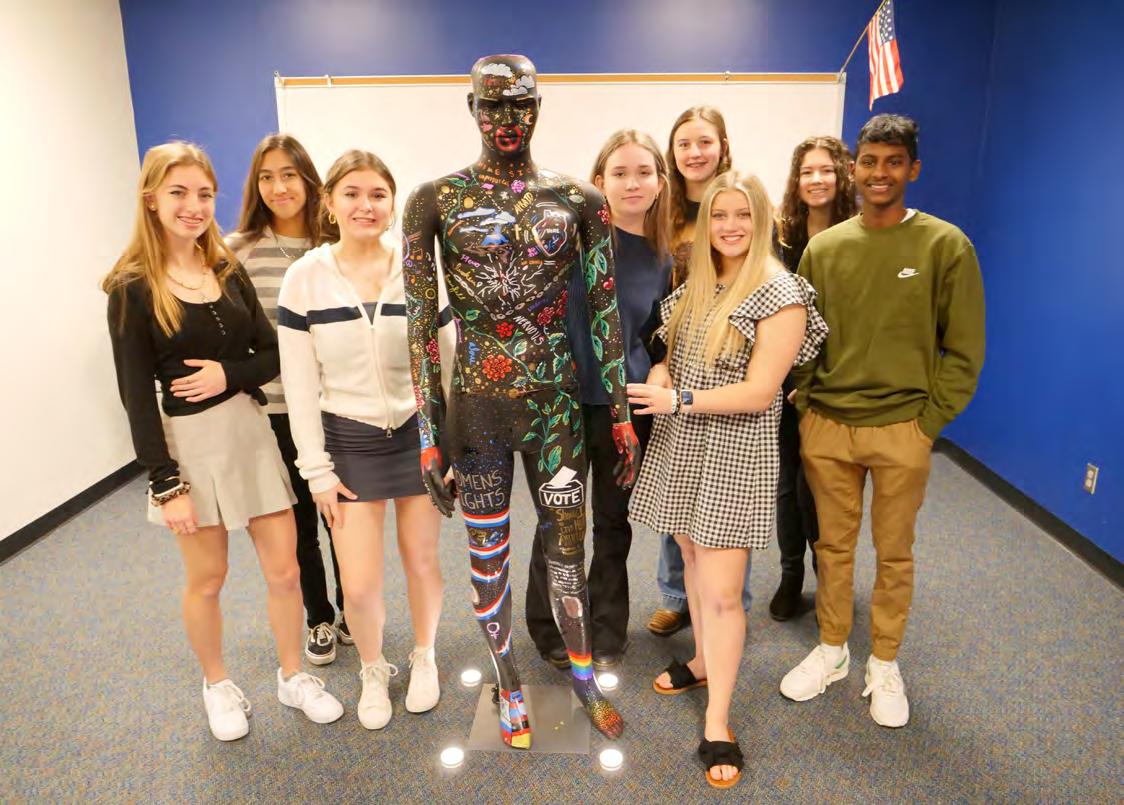
Next up is a unit on ancestry and the American dream. Students focus on immigration and what brings people to America. They each complete an ancestry project, focusing on one of their family members, and present these at a parent night. Truman and Stephenson ask parents to write letters to their students to present to them at the end of the night, expressing their own American dreams and the ones they have for their children.
“Every year we have parents who come and get emotional because their child knows more or as much as they do about their grandpa and their history,” Stephenson says.
The final nine weeks’ project is called Change My Mind, and it’s just what it sounds like. With no topic deemed off-limits, students choose an issue and write a research paper. Combining
26 BRAGGING RIGHTS 2022-2023 Texas School Business
▲ Students in the combined curriculum classes do not take traditional tests or quizzes, but instead work on discussion and project-based tasks.
what they’ve learned about themselves, their families and their community in the previous units, students choose a stance on the issue and debate it in class with their peers.
“We want them to learn how to have an opinion and have facts that will back up their opinions,” Truman says. “We want them to know how to have a conversation with people, not just argue and yell, but to discuss and then, at the end of the conversation, shake hands and go about your business.”
Other FHS classes come join in the debate, and at the end of the unit, the students set up an exhibit in the gymnasium, inviting others to sit down and have one-on-one conversations, using the skills they’ve learned to defend their positions and model civil discourse.

Thus far, the combined curriculum has been a hit. After originally teaching just one of the courses, demand has increased enough that Truman and Stephenson teach two of the combined classes during their day. Stephenson says the most valuable feedback she gets is seeing seniors return to the classroom to express how much they miss the class.
“They miss this class and mostly they say it’s because it felt like a family. It’s the conversations, it’s sitting with different people every three or four weeks. They really get to know each other and build relationships and foundations with students they didn’t even know but they’ve gone to school with their whole lives.”
Hillier says she drops into the class from time to time and winds up standing in the back of the room in awe, observing the way students interact differently than in other classrooms.
“You walk into a traditional classroom and the teacher is leading the discussion,” she says. “They’re asking questions and hesitantly, students who know the answers will answer the questions and the others will just sit quietly. After two or three weeks in this class, there is a safety to that environment where the kids are truly not afraid to speak up. Even if their opinion is different from others in the classroom. And what I love about it is it’s not a hostile dialogue. They can have a conversation.”
Kicking off a program that flips the education model is a big step, and Hillier, Truman and Stephenson say the class’s first year was
full of failures and on-the-fly changes. Hillier credits the teachers for keeping the program going by being flexible and willing to adjust as needed.
“I can’t express how important it is to have the right people in this spot,” she says. “These two didn’t give up. They just said, ‘OK, that didn’t work. What now?’”

Truman and Stephenson say the model is still evolving, and even the two classes they currently teach look different from each other. Being flexible means sometimes letting the students lead, and following the direction the kids take them.
“We cater to the kids and what their strengths are,” Stephenson says. “Teachers have to be able to fly by the seat of their pants and walk out of class each day going, ‘OK, what are we doing tomorrow?’”
The success in this combined class has kicked off conversations across the district and beyond. Stephenson says other FHS teachers are looking at how they can switch up teaching methods in their own classrooms. A group of elementary school teachers in the district, the Leading Learners, are making a plan to combine two classes and do something similar at the lower grade level.
Hillier, Truman and Stephenson agree that the most important thing administrators can do when trying to create similar change in their districts is to trust their teachers.
“The freedom our admin gave us is amazing,” Truman says. “There’s no, ‘You’ll have to do this. Don’t cover that. Don’t talk about this.’ Everything we do and ask for, they say, ‘How can we help?’ That is the number-one reason, I think, why this class is successful in the first place. If we didn’t have that, it wouldn’t work the way it does.”
Hillier credits Mark Griffon, principal at FHS, for supporting the program from its infancy and through its growing pains.
“I think we all get into a rut with education and look out there and know that what we’re doing is not best for the kids,” she says. “It’s not best for learning, it’s not best for anything, but it’s the way we’ve always done it.”
27 BRAGGING RIGHTS 2022-2023 Texas School Business
Dacia Rivers is editorial director of Texas School Business.
▲ Stephenson and Truman share the classroom, working as a teaching team.
▲ Each year, students host a war museum exhibit for the entire school to visit.

GROESBECK ISD
The right tool for the job
by Bobby Hawthorne
Dr. James Cowley has a plan. It involves a house with two bedrooms and two baths that’s on a lot the Groesbeck Independent School District owns, or will eventually.
A teacher will live in that house, and it’ll save that teacher the wear and tear of driving back and forth every day from Waco or Fairfield or Mexia, and perhaps that’s all it’ll take to convince this teacher to settle in and buy in to everything a little country school like Groesbeck has to offer.
Cowley’s in his fifth year as superintendent here, and he didn’t need long to see how nicely his plan dovetailed with the local realities.
Of course, what he didn’t see was COVID-19, which threw everything into a tizzy, and then the school shootings at Santa Fe and Uvalde,
which spawned an avalanche of costly and timedevouring security mandates.
Given the social, financial and instructional chaos of the past five years, Cowley could not have been faulted for moving his plan to a back burner, but he refused to.
The kids at Groesbeck High will build a house. The school district will rent it to teachers as they come into the district, those teachers will remain on staff, and everyone will benefit.
That’s still the plan, and Cowley has hired the right man to make it so. That man is Kevin Ensminger. A GHS grad, he’s been in construction for almost 40 years, starting off as a laborer and working his way up to job superintendent.
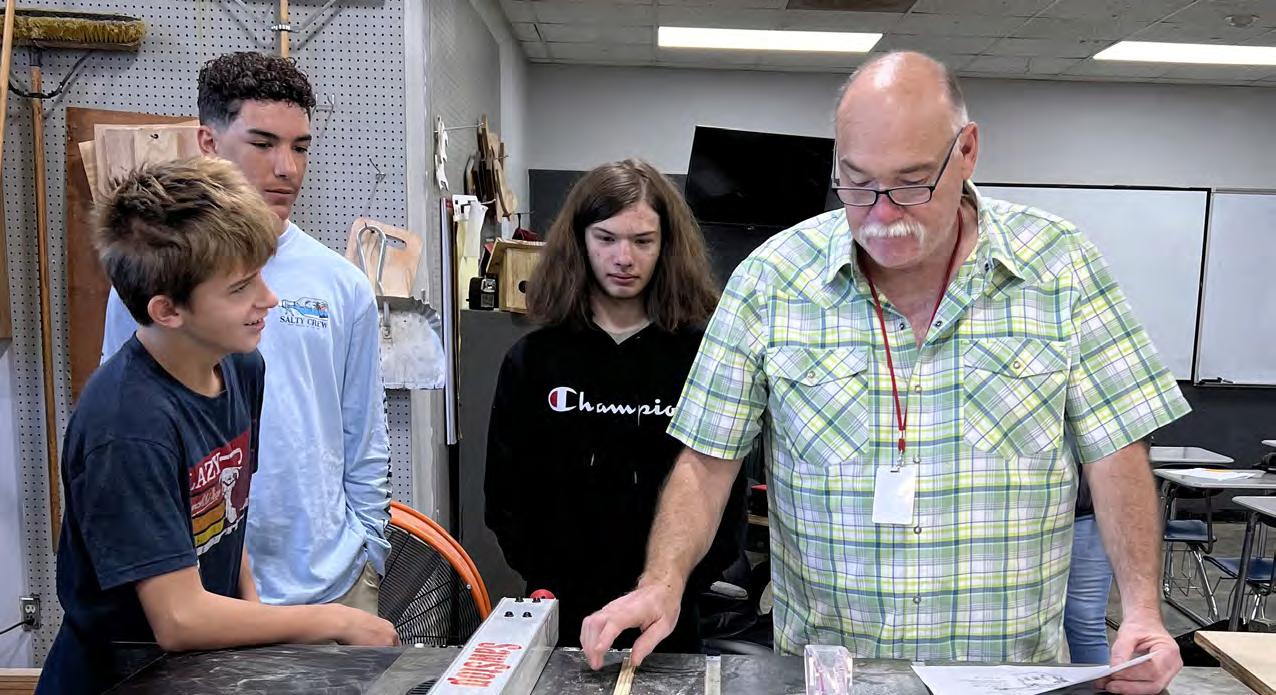
29 BRAGGING RIGHTS 2022-2023 Texas School Business
▲ Kevin Ensminger leads students in the Carpentry Pathway CTE program in Groesbeck ISD.
Groesbeck Carpentry Gateway program aims to prepare students and house educators
Groesbeck ISD County: Limestone Region: 12 Superintendent: James Cowley 2020 enrollment: 1,607 Number of schools: 4
While working in Austin, he met a girl named Cynthia. They married and moved back to Groesbeck, and he started a construction firm, specializing in houses, metal commercial structures and “barndominiums,” which are hybrid hangars, residences, tool sheds and whatever else might be called for.
Cynthia, meanwhile, went to work for the school district. She was an assistant principal at the junior high when Cowley arrived. When she learned that he wanted to create a carpentry program, she introduced him to her husband. Though Ensminger didn’t have a college degree, he had more than enough experience to be considered an expert in his field.
So, Ensminger met Dr. Cowley, and the two hit it off, and now, Ensminger’s still banging away, building the program one board and one nail at a time.
“When we started, there was a wood shop, but it wasn’t much of one,” Ensminger says.
It helped that Cowley’s two children had both taken CTE classes and benefited greatly from them. His daughter is now a veterinarian, and his son is an accountant. The CTE classes they
took provided them a chance to figure out what they wanted to do, and the skills to do it with.
Ensminger’s now in his fourth year with the district, and his classes are growing in size and scope. Partnerships are being forged, and budget kinks are being ironed out. Ensminger said he hopes work on the house will begin soon, possibly next year. By then, his seniors should be ready, even though some of them came into the program not knowing which end of a screwdriver to hold. “When we were growing up, we learned how to use a hammer and pair of pliers because we had chores. If something around our house broke, we had to fix it,” he says. “That doesn’t happen so much these days. Kids come from families that often don’t own their homes, so if something breaks, they just find someone to fix it.”
So, beginners learn tools, materials and safety first. The day I visit, Ensminger is demonstrating a table saw.
“Our table saw is one of the safest on the market,” Ensminger says. “It’s called a ‘SawStop.’ It actually comes to an immediate and complete halt if it comes into contact with human skin.”

30 BRAGGING RIGHTS 2022-2023 Texas School Business
▲ Safety is paramount in Ensminger’s classroom, and carpentry students learn to create with safety at the top of their minds.
Not all saws are this safe, and Ensminger wants his students to appreciate the dire consequences of even a second of inattention. This year, the carpentry kids are building what might be considered a cabin. Nucor Steel, which is located near Jewett, about 30 miles east, is a major donor of material, especially wood pallets. It doesn’t hurt that one of Ensminger’s daughters works there.
Ensminger has pitched in tin siding and pine boards that he salvaged from an old carriage house on his property. The pine boards were milled locally a century or more ago, he says. Though it’s hard to believe, the East Texas pine forests reached as far west as Groesbeck back then.



The lesson learned? Sometimes, you go with what you got.
“We’re not just teaching kids how to swing a hammer,” Ensminger says. “We’re teaching them how to use what they have. We want to teach them to think creatively. From the first day, the goal was to teach kids how to do stuff.”

So, is there a two-bedroom, two-bath house in Groesbeck’s future? Will Ensminger have trained his juniors and seniors to tackle such a major endeavor?
Time will tell.
What if there’s another unexpected glitch?
Then, so be it. Work goes on. The plan does not go to the back burner.
“Even if we don’t build a house right away, we’re still giving these kids something they’ll never get anywhere else,” Ensminger says. “They’re learning how to read a tape measure, how to climb a ladder safely, and how to change out a wall outlet. These are lessons some of these kids are never going to learn anywhere else, lessons they’ll use for the rest of their lives.”
Bobby Hawthorne is the author of “Longhorn Football” and “Home Field,” published by UT Press. In 2005, he retired as director of academics for the University Interscholastic League.
31 BRAGGING RIGHTS 2022-2023 Texas School Business
▲ Carpentry students in GISD have used reclaimed wood to build furniture.
HUTTO ISD
Hutto
by Bobby Hawthorne
Brandon Peterson was no stranger to cars when he enrolled in “Auto technology basics.”
“My dad has a shop,” the Hutto High School senior says. “He used to work on 18-wheelers, so I was kind of born around cars.”
Tall and slender, Brandon resembles a young Tom Brady, so I have to ask, “Do you play sports?”
“Nope,” he says.
“Participate in any extracurricular activities? Music, perhaps?”
He flashes a gap-tooth smile, shakes his head and answers, “Nope.”
“So, this is it for you?”
“Yep,” he says.
“If it weren’t for this program, where do you think you’d be?”
“Probably not here,” he says, meaning, “Probably not at Hutto High.”
Because of the auto tech program, he’ll graduate this spring with the skills needed to land a job in the real world — a car dealership or an auto repair shop. Maybe even his dad’s shop. His goal is to become a diesel engine mechanic.

“Is that work complicated?”
“Not if you know what you’re doing,” he says, without smiling a lick.
Brandon knows what he’s doing. Jeff Milam has made sure of that.
32 BRAGGING RIGHTS 2022-2023 Texas School Business
ISD’s auto-tech program creates career-ready grads
▲ Students in Hutto ISD’s auto-tech program learn hands-on skills that prepare them for careers in the industry.
Hutto ISD County: Williamson Region: 13 Superintendent: Celina Estrada Thomas 2020 enrollment: 8,110 Number of schools: 11
Now in his 21st year of teaching, Milam’s in charge of a program that has grown in four years from 60 students to almost 250. He attracts more and more students because he’s made it real, relevant and fun.
“On Day One, I say, ‘This is an elective but it also could be a career choice. I’m going to explain everything you’re going to be doing for the rest of the year because I want you to know what you’re getting into.’”
If they’re still there in two days, he figures they want to be there, so he sets the ground rules. Expect to work. Expect to be involved. Don’t be surprised if you scrape a knuckle or smash a finger. Now, let’s go to work.
This is important to Milam, because he took shop years ago at Hereford High School, and he remembers some of the stigma attached to the kids who toiled down in the bowels of the school. He remembers how the teacher chose a few favorites and allowed the rest to set their own agendas.
“Back then, some of them mostly hung out behind the gym, smoking cigarettes,” Milam says. “I never wanted to be that kind of shop teacher.”
How he became a shop teacher of any kind is interesting. After high school, Milam attended aircraft mechanics school in Tulsa, didn’t like it, tried his hand at drafting, didn’t like it, accepted a job


as an apprentice mechanic at a Tulsa Buick dealership and didn’t like it enough to stay.
He and his wife returned to Hereford, where he again worked on aircraft — mostly so-called “spray” planes and crop dusters. He liked it, but his paycheck was as thin as the powder he drizzled on cotton. Also, he had developed a few health issues — mostly from bending over and picking things up — so he purchased a Mac Tools route, which he ran until that company went bankrupt.
Then, it was back to the garage.
One day, a good friend who taught at Hereford High suggested he consider teaching.
“I thought he was nuts,” Milam says. “But I talked to my wife about it, and she said, “You know, there is something there. You like kids. You get along with them real well. Maybe you should think about it.”
So, he did. He’d been a Cub Scout and Boy Scout troop leader as well as a youth leader at church. He figured, “I’m just a big kid myself. How hard could it be?”
Hereford ISD hired him to teach a class called Energy, Power & Transportation. The kids called it “EPT,” which is also an acronym for something else.
Anyway, Milam taught it for a year, during which he developed

33 BRAGGING RIGHTS 2022-2023 Texas School Business
▲ Jeff Milam teaches students in HISD’s auto-tech program, a program that has grown from 60 students to nearly 250 in just four years.
“Career and Technical Education programs, particularly the automotive technology program, serve a vital role in our high school. They provide a vital means for students to learn and obtain viable, highly sought, employable skills that set the students up for immediate employability and long-term success. The confidence skills alone these programs build in our students are worth the investment, not to mention the return over a lifetime.
I am a firm believer in promoting, sustaining and expanding CTE programs in Hutto ISD.”
— Celina Estrada Thomas, superintendent, Hutto ISD
‘workbench skills.’ Taking apart starters, alternators and single cylinder engines, putting them back together and seeing if they still work.”
He works right alongside them.
“We get a lot of scraped knuckles,” he says. “The kids will look at me and say, ‘Mr. Milam, you’re bleeding again.’”
It’s a small price to pay.
“I’ve been blessed with administrators who’ve enthusiastically supported my program,” Milam says. “If I want to start something new — an electronics class, for example — they’ll say, ‘Well, let’s talk about it.’”
One of those administrators is Travis Clark, Hutto ISD’s CTE coordinator.
“This program was stagnant,” Clark says. “We hired him, and it began to grow. When it reached the point where we needed a second teacher, Milam went after one of his biggest competitors, Tony Martinez [who was teaching automotive tech in another district]. A lot of people would have shied away from that, but Milam wanted Tony on his team.”
The program then grew enough to warrant hiring a third teacher, Matthew Johnson, a third generation mechanic and a second generation automotive teacher. Born in Taylor, he once baled hay on the land where Hutto High currently sits.
Together, Milam, Martinez and Johnson oversee a program that’s growing at a more rapid rate than the district itself.
“It’s because of the kind of people we have,” Clark said. “They get every one of their students involved, and they believe that all students can learn the materials, do the skills and succeed, whether that’s attending a trade school or getting a job right out of high school.”
By the way, their recent graduates who enter the auto-tech field are making upwards of $27 per hour plus benefits. That works out to around $54,000 a year.
As for the kids who aren’t sure what they’re going to do right out of high school, they benefit as much or more.
“It’s not all just about fixing cars,” Milam says. “I make my students write tickets and get on the phone and order parts. If we’re working on a teacher’s car, I have them deliver the keys and explain what we did to their car and why we did it, so they’re learning more than just how to turn a wrench. They’re learning people skills.”
migraine headaches bad enough to send him to the emergency room.
“Nerves,” he says. Eventually, they went away, and he did, too. The next year, he moved to the high school, where he taught a class on small engines, and he might have stayed in that job until he retired if his oldest son hadn’t accepted a job with National Instruments in Austin.
Though it almost killed him to leave West Texas, Milam and his wife followed their hearts and their new grandchild to Round Rock. He taught at Rouse High School in Leander ISD, then four years ago took on the challenge of reviving the Hutto program. “The first year is about 50% theory,” Milam says. “We say theory instead of books. Sounds better. A lot of it is what I call
Brandon says one thing he’s learned — above and beyond everything else — is simply the proper way of doing things.
“I always have someone double check my work,” he says. “I always make sure the customer is happy.”
Is the program expensive? Of course. CTE programs tend to be. “But here’s what administrators and board members — all those folks who make the money decisions — need to understand,” Milam says. “If the program is realistic, and if it’s real-world, and if it’s relevant, then it’s worth every stinking penny.”
Bobby Hawthorne is the author of “Longhorn Football” and “Home Field,” published by UT Press. In 2005, he retired as director of academics for the University Interscholastic League.
34 BRAGGING RIGHTS 2022-2023 Texas School Business
IRVING ISD


 by Stacy Alexander Evans
by Stacy Alexander Evans
Rock musician Jason Barnes was declared the “fastest drummer alive” after the Georgia Institute of Technology outfitted the tattooed amputee with a bionic arm in 2014. Six years later, German professor turned DJ Bertolt Meyer transformed his disability into a superpower by attaching a converter — instead of a hand — to his prosthetic arm, taking his electronic music to new heights.
Indeed, through the wonders of modern technology, it seems that “disabled” adults can now have a competitive edge on their peers in the popular music world. But for self-conscious students in middle school, it’s all about blending in. Such was the case for sixth grader Khen Hoih, who sought to play violin for the orchestra when
he started school last fall at Lorenzo De Zavala Middle School in Irving.
Orchestra teacher Jillian Attan recalls her surprise that first week of school, when she discovered Hoih was missing the bottom half of his left arm.
“We were not notified prior to the start of school that anything would be different for him — he just signed up for orchestra,” marvels Attan. “We found out later that Kehn had lived his whole life without accommodation.”
But, as soon as Attan realized Hoih, lacking digits, would not be able to depress the strings on the neck of his instrument, she knew exactly who to call. Enter engineering teacher and U.S. Navy veteran Dwight Davison.

35 BRAGGING RIGHTS 2022-2023 Texas School Business
All for one and one for all Irving’s inter-school collaboration helps orchestra star shine
▲ Engineering students in Irving ISD work to create a prosthetic arm for a fellow student so that he can fulfill his dream of playing the violin.
Irving ISD County: Dallas Region: 10 Superintendent: Magda Hernández 2020 enrollment: 33,453 Number of schools: 37
Davison holds court at nearby Nimitz High School, and in 2019, he and his students had worked on a prosthetic limb for another student in the district, Kayla Arqueta, who wanted to play the cello at Austin Middle School. Although the team at Nimitz initially intended to modify the blueprints from Arqueta’s device, the job proved to be more challenging than they anticipated.
“It ended up being 100% new,” says Davison. “We looked at those prototypes, but then the students quickly realized that it wasn’t going to work.”
Davison explains that the physical differences between Hoih’s and Arqueta’s arms, as well as the structural differences between the cello and violin, meant a necessary return to the drawing board for his team.
For the Hoih project, that team consisted of four Nimitz seniors: Christian Erazo, Americo Guerrero, Julian Jimenez, and Anthony Daigle. Asked if it was a coincidence that two of the students were musicians, Davison says that any time he puts a call out for team members, he definitely keeps in mind the applicant’s potential buy-in to a specific project.
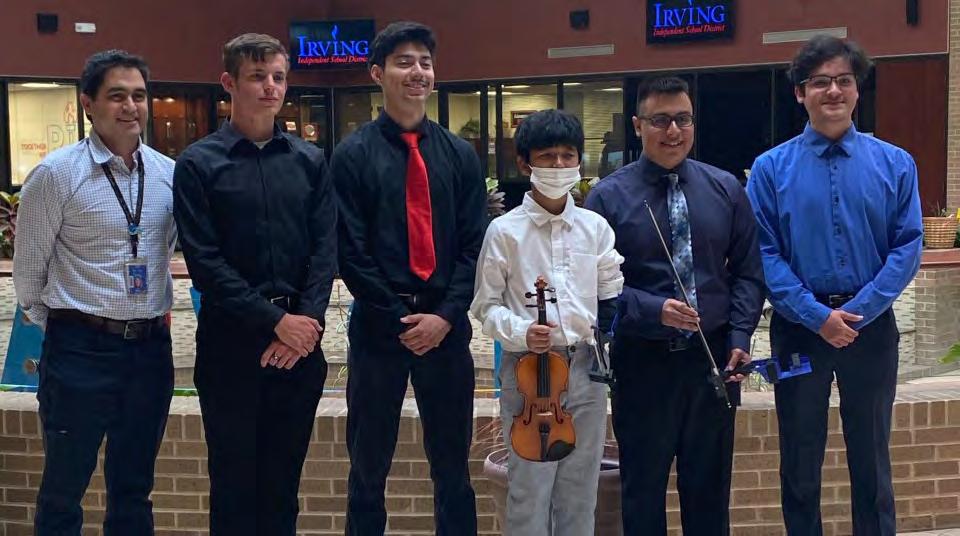
“They all had really good reasons for wanting to participate,” he says.
In their junior year at Nimitz, engineering students learn Autodesk’s Inventor program, in which they ultimately become certified. By their senior year, they’re ready to print their 3D models and make their dreams tangible realities. They also have
the opportunity to compete for a spot on special projects such as this one.
Once Attan put out her fateful call for assistance, Davison mobilized his troops.
“I remember saying to them, ‘when you’re in middle school, it’s pretty rough — and people make fun.’”
Davison knew that the socially pressurized environment of middle school would still be fresh on the minds of his high schoolers. Appealing to their humanity first, he says, was a conscious step toward boosting their emotional intelligence.
“We really need to work on our people skills. Engineers are sometimes ‘all about the facts,’ but I knew we needed to get to know Kehn and make him feel comfortable while he was here.”
In the end, Davison was confident he’d assembled a group of students who were up to the task on that front.
Once the team was established, the two schools made arrangements for Hoih to be fitted. Plans were drawn up, adjustments were made, and by November of 2021, Kehn Hoih received his final prosthetic device, which was made of carbon fiber PLA. Not surprisingly, Davison says the biggest hurdle was logistics.
“I would say the biggest challenge was not having Kehn here all the time. We were doing a lot of guesswork,” he laments, “because the school year is only so long, right?”
36 BRAGGING RIGHTS 2022-2023 Texas School Business
▲ Irving ISD sixth grader Khen Hoih was able to play the violin after students from Nimitz High School worked to build him a prosthetic limb.
Although Davison was wowed by his students’ technical prowess throughout the process, it was another collective quality of theirs that made a lasting impression: their intensity.
“Anybody who was in that room the first time they were fitting him — we were all in awe watching this unfold in front of us. We could see Hoih let his guard down as the kids came in around him. Seeing that passion there was quite a treat.”
When asked to what degree the other orchestra students remarked on Hoih’s incredible journey this year, Attan is grateful for the distinct lack of buzz on the middle school campus.
“That’s really the ideal situation,” she says, “because we wouldn’t want him to feel like he’s doing anything different.”
She does admit that in those first couple of weeks with the new device, students often rushed to help him put up his case, but Hoih soon put a stop to that.
“He said ‘I can do it myself, it’s not a big deal.’” Although many would describe the incredible results of this Irving ISD team’s collaborative effort as a very big deal, Hoih is right about one thing: He can now do it himself.
Stacy Alexander Evans is a freelance writer based in Austin. She is a state-certified secondary teacher who spent four years working with stu dents throughout the state of Texas.
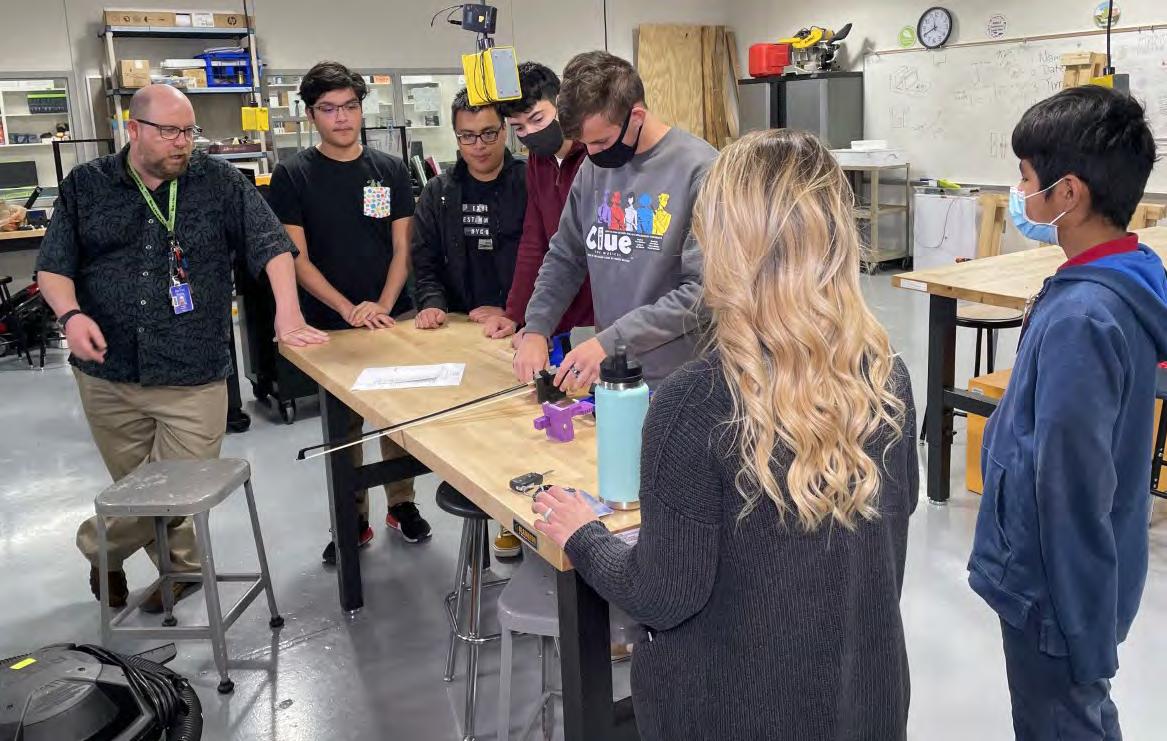
37 BRAGGING RIGHTS 2022-2023 Texas School Business
Davison knew that the socially pressurized environment of middle school would still be fresh on the minds of his high schoolers. Appealing to their humanity first, he says, was a conscious step toward boosting their emotional intelligence.
▲ Engineering teacher Dwight Davison leads the team of students in the creation of the prosthetic arm.
NORTHSIDE ISD
Northside ISD supports fathers, strengthens families
by Dacia Rivers
Study after study has shown that children thrive when they grow up with strong male role models in their lives. In Northside ISD, Brenda Faz-Villarreal, a coordinator in the Whole Child Development department, knows personally just how true that fact is.
When Faz-Villarreal joined the district as a counselor more than 30 years ago, she kicked off the Strong Fathers + Strong Children = Strong Families program, inspired by the research she’d read and her own experiences as a child.

Born to a single mother, Faz-Villarreal’s father was not involved in her life at all. She says his absence affected her greatly.
“I wondered what I had done wrong, because he
had nothing to do with us,” she says. “I felt like I had done something wrong, and that turned into, maybe I wasn’t pretty enough, or I wasn’t smart enough. Something must be wrong with me.”
When Faz-Villarreal was in elementary school, her mother met a man named Luis Faz, and the two fell in love and got married. Faz-Villarreal, who hyphenated her last name to include her stepfather’s, says that while she felt the loss of her biological father, through Faz, she had found her “daddy.”
“He showed me what a dad was. He was there for me. He cared about my education.”
Northside ISD, in the San Antonio area, is a large school district that includes several Title 1 schools.
38 BRAGGING RIGHTS 2022-2023 Texas School Business
▲ Northside ISD hosts a Strong Fathers + Strong Children = Strong Families event to support and educate male role models in the district.
Northside ISD County: Bexar Region: 20 Superintendent: Brian Woods 2020 enrollment: 107,135 Number of schools: 121
In designing the strong fathers program, Faz-Villarreal decided to start with these schools, in an effort to reach the families who need the support most.
Now in its 23rd year, the program is a half-day event, held on a Saturday when many fathers, or father figures, can more easily attend. Faz-Villarreal says attendees can be any male role models, from step dads and uncles to granddads and neighbors. Anyone who’s helping to raise a child is invited, and translation devices are available for non-English speakers.
“We tell them to come and bring their children with them — their babies, toddlers, elementary, middle and high school age children,” Faz-Villarreal says. “We tell them we’re going to have a fun time playing games, and at the same time learning and bonding. That this is going to make them all strong fathers, which is going to equal strong children, which is going to create a strong family.”
The event kicks off in the morning with a continental breakfast and music, while dads and kids arrive and mingle. Then staff takes the kids to different, age-appropriate rooms where they do crafts and projects and write letters, or draw pictures, for their dads.
At this year’s event, held in May, the dads heard from Northside Superintendent Brian Woods, who kicked off the morning by sharing stories from his own experience as a father — the good,
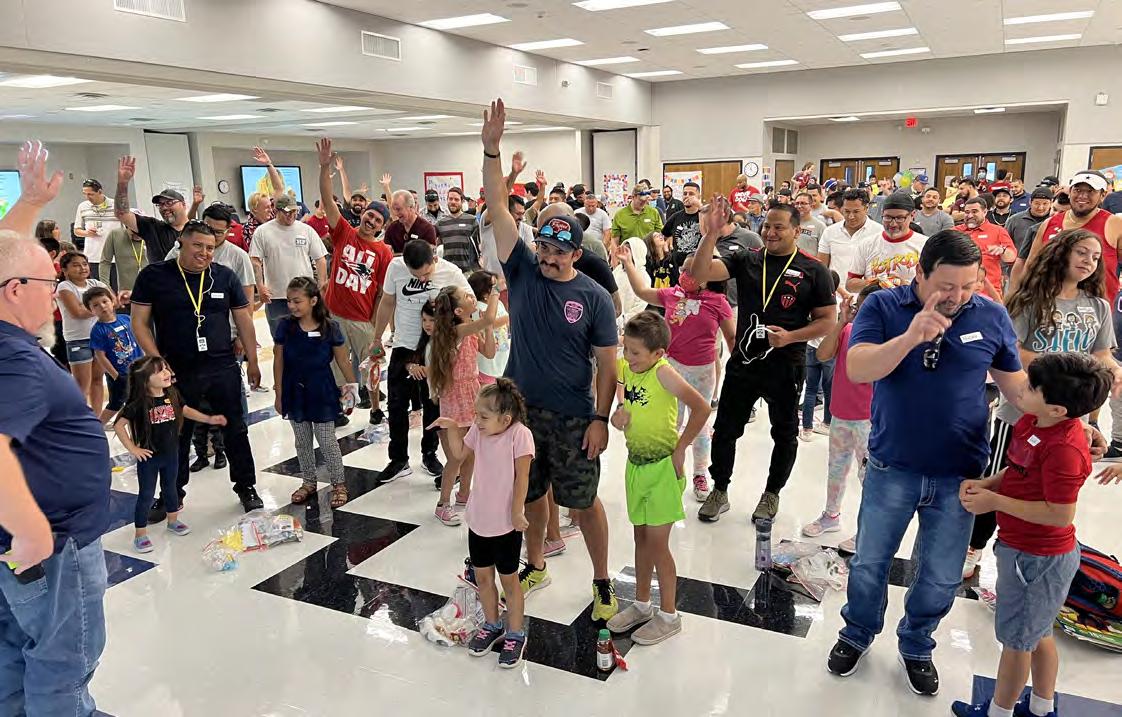
the fun and the challenging. Faz-Villarreal says it was a touching moment, especially for her, as she’s worked in the district with Woods for several decades.
“He was very honest and very vulnerable,” Faz-Villarreal says. “It was very special.”
Following Woods’ presentation, another speaker took the stage to discuss the importance of male role models. Speakers so far have included Ron Klinger of the Center for Successful Fathering and Mike Hall, CEO of Strong Fathers-Strong Families. At this year’s event, Hall spoke about the research showing the strength and importance of fathers in their children’s lives.
After speaking, Hall asked attendees to split into groups and asked them to work on questions together, such as: “What are the strengths of a father?” and, “What do you want your child to be?”
The men in the audience talked about these topics with each other, learning from each other about the many forms their roles as father figures can take.
“Sometimes a dad will say, ‘I thought I just had to work and bring in money, but no, I’m more important to my child than I thought,’” says Faz-Villarreal. “It’s very powerful. A lot of them talk about how they’ve all come from different backgrounds, but they all want the same thing.”
39 BRAGGING RIGHTS 2022-2023 Texas School Business
▲ Strong Fathers is a half-day, hands-on event created by Brenda Faz-Villarreal.
Following this discussion, staff bring the children back into the room to be reunited with their family members. That’s when the games begin.
Faz-Villarreal says the games are a big hit. Presenters explain to the adults the importance of playing with their kids. They talk about how dads might play differently with their children than a mother might, whether it’s more active or more roughhousing, and explain that that’s not only OK – it’s important.
At the event, the groups play hands-on games such as chasing the dragon’s tail, or passing a Hula-Hoop to each other while holding hands. When the games are done, the speaker will read a book to the attendees, encouraging adults in the audience to go home and do the same, modeling active and interesting reading, reading with different voices, and other techniques for keeping children engaged and making a connection beyond the words.


Hall also asks the dads to sit down with their children, look them in the eye, and tell them about their own childhoods. He’ll provide specific prompts, encouraging the dads to connect with their children by sharing more about themselves and what their younger selves were like.
Lastly, all adults and kids sign a contrast, pledging to spend time together, whether it’s helping with homework or reading bedtime stories. The adults then fill out an evaluation form, offering their feedback, before the event winds up. No one goes home emptyhanded — the district sends families home with goodie bags containing books to help build their home libraries, board games and other activities they can enjoy as a family.
Faz-Villarreal says feedback for the events is always overwhelmingly positive, with some dads wishing the event could
last longer. She says the district works hard to provide a top-notch program for the families, since many of them take the day off from work to attend, and some come from out of town, as far away as Houston and Dallas.
Anna Lisa Rodriguez, grants and recognitions coordinator in the district, says the program helps male role models better understand their own importance.
“The relationships they build with their children have long lasting effects on their education and their growth and development, from children into young adults and adulthood,” she says. “And they gain a greater understanding of that through this event.”
While Strong Fathers + Strong Children = Strong Families events have been somewhat sporadic over the past few years, both Faz-Villarreal and Rodriguez say they hope to eventually hold the program yearly. The only obstacle to that is funding, which Faz-Villarreal hopes will improve with the recent development of the Whole Child Development department in the district. She says Northside has secured funding for this school year and will be hosting the event again in May 2023.
More than 20 years after envisioning the program and helping it become a reality, Faz-Villarreal says her main goal remains the same as it’s always been: showing dads their importance.
“I want the dads to know that they’re important. They’re important to a child, and they have an effect on them.”
40 BRAGGING RIGHTS 2022-2023 Texas School Business
Dacia Rivers is editorial director of Texas School Business.
▲ During the event, father figures receive encouragement and practical parenting tips.
PEWITT CISD
The giving trees
by Stacy Alexander Evans
For most new teachers, that first year in the classroom is brutal. Many would agree that middle school is the most challenging environment of all. Tasked with building a respectful community among students who possess both childlike energy and adolescent angst, even the most experienced educator can be humbled by the prospect. Yet harnessing that chaos and directing students’ abundant energy to drive learning is critical if teaching goals are to be met.
For Pewitt CISD, that didn’t happen in 2020. Pewitt Middle School received a grade of D that year from TEA.
Superintendent Melissa Reid had taken over her position in January of 2020, just before the COVID-19 pandemic gripped the nation. Excited to get started in her new role, her enthusiasm was

soon tempered by the harsh realities of a global health crisis. When the hammer came down from TEA, there was no time to waste. She started by building a sense of trust among her staff.
“People were dying,” recalls Reid thoughtfully, “but because of that, it really forced me to reflect on what is important, and building relationships is important. I think the idea of implementing changes to instruction was easier because people knew that I cared about them as people first.”
With its goal of “Supporting Educator Excellence Daily,” PCISD launched S.E.E.D. at Pewitt Middle School in the fall of 2021. Although new teachers were the program’s prime focus, the district also offered services to veteran educators as well as those new to STAAR. Reid acknowledges that teachers who have been in the classroom for a
41 BRAGGING RIGHTS 2022-2023 Texas School Business
CISD’s
Pewitt
S.E.E.D. program provides fertile ground for sapling teachers
▲ Pewitt CISD’s Supporting Educator Excellence (S.E.E.D.) program aims to build a supportive, family-like culture among teachers in the district.
Pewitt CISD County: Morris Region: 8 Superintendent: Melissa Reid 2020 enrollment: 870 Number of schools: 3
while face a different set of challenges and frequently benefit from learning to use new technology or collaborating with younger teachers on fresh, Gen Z-approved lessons.
In the final analysis, the S.E.E.D. strategies — including classroom visits (followed by feedback and debriefing), modeled lessons, co-teaching, and mentoring — were a success. This August, Pewitt Middle School received a grade of B from TEA.
When asked about the program’s most critical component, Reid doesn’t hesitate. She points to her curriculum coach, Darlene Greenlee, a woman with a special talent for bringing out the best in new teachers. The two met at New Boston ISD in 2017, when Reid was a principal and Greenlee was a teacher. Determined to boost Pewitt Middle School’s TEA score, Reid began to ruminate on what kind of leader she sought to put in charge, and she knew she would need someone who was as patient as they were knowledgeable. To her, former colleague Greenlee was the obvious choice.
“When I came to Pewitt,” Reid says, “I made sure that I brought her with me, because she’s just that fabulous.”
Greenlee gladly picked up the gauntlet. “I’ve been in education 23 years,” she says pensively, “but I still remember how it was being a new teacher. I was also fortunate to be able to do the Learning Roundtable: Building a Stronger Texas event in 2019 with the Commissioner of Education, Mike Morath, and that was about a mentor program for Texas teachers as well.”
In the final analysis, the S.E.E.D. strategies — including classroom visits (followed by feedback and debriefing), modeled lessons, coteaching, and mentoring — were a success. This August, Pewitt Middle School received a grade of B from TEA.
Although she was confident this foundation would serve her well as S.E.E.D. administrator, Greenlee was mindful of the specific difficulties facing a rural district such as Pewitt, where many of their new recruits each year are pursuing alternative paths to certification. Lacking the standard, mentored year of student teaching required by traditional programs, she recognized these teachers often burned out quickly, and would need to be handled with care.
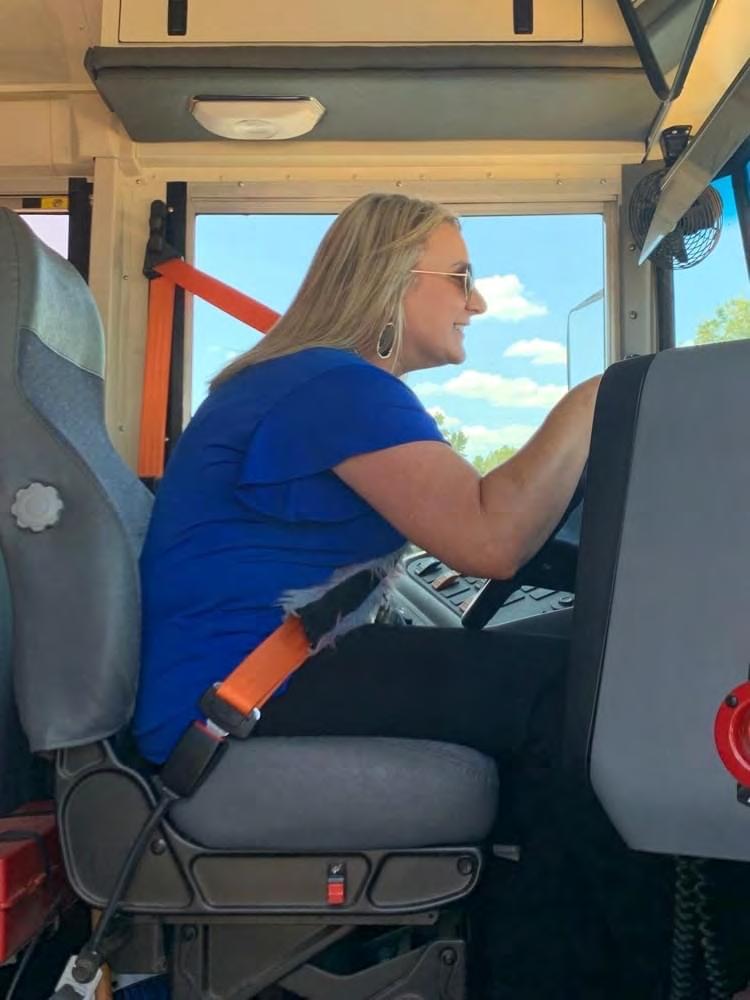
Reid agrees. “They were coming to us without a lot of knowledge in how to teach. They knew their content pretty well, but they just didn’t know how to relay it in order to get kids really engaged.”
Thus, although their goals with S.E.E.D. were ambitious, the team consciously strove for simplicity. Knowing how overwhelmed new teachers often are, the last thing they wanted was to add to their substantial lists of “things to do” in a given day. The solution? A brochure given to every teacher on campus with a QR code that would take them directly to the Instructional Support Request Form.
From the moment TEA unveiled its A-F rating system in 2018, clickbait headlines within education groups on social media inspired a veritable panic among teachers and administrators fearful of losing their jobs. In some districts, posters complained that the “crime and punishment” climate felt threatening and unhealthy.
42 BRAGGING RIGHTS 2022-2023 Texas School Business
▲ Superintendent Melissa Reid takes the wheel behind one of PCISD’s school buses.
In contrast, at Pewitt, the S.E.E.D. philosophy truly brings to mind the image of seedlings in the protected environment of an atrium, basking in the glow of a life-affirming heat lamp. A punitive response is the last thing the superintendent wanted.

“Miss Greenlee is there to support the teachers and build a relationship with them — we really have a great family culture here,” says Reid. “When I go into a classroom, or when our principal goes into a classroom, it’s a little more intimidating. But Miss Greenlee’s position is not intimidating at all. She is there to support them, not to give them consequences or anything like that.”
Next year, the district plans to bring its successful S.E.E.D. program to other schools in the district.
Stacy Alexander Evans is a freelance writer based in Austin. She is a state-certified secondary teacher who spent four years working with stu dents throughout the state of Texas.

43 BRAGGING RIGHTS 2022-2023 Texas School Business
▲ The S.E.E.D. program aims to support first-time and veteran teachers alike.
▲ Superintendent Reid poses with Curriculum Coach Darlene Greenlee when the latter won teacher of the year.
by Leila Kalmbach
For many, the concept of a teaching internship conjures up images of student teachers sitting in the back of a classroom until it’s time to pass out handouts, or keeping an eye on the class while the teacher steps out to make coffee. For Socorro ISD, however, aspiring teachers don’t just observe — they get true on-thejob training.
Since 2019, SISD has been partnering with The University of Texas at El Paso (UTEP) to create the Teacher Residency Program, an immersive experience for students finishing up their teaching certifications. The district and university carefully crafted the program to create an experience that benefits not just the aspiring teachers, but also the mentor teachers, students
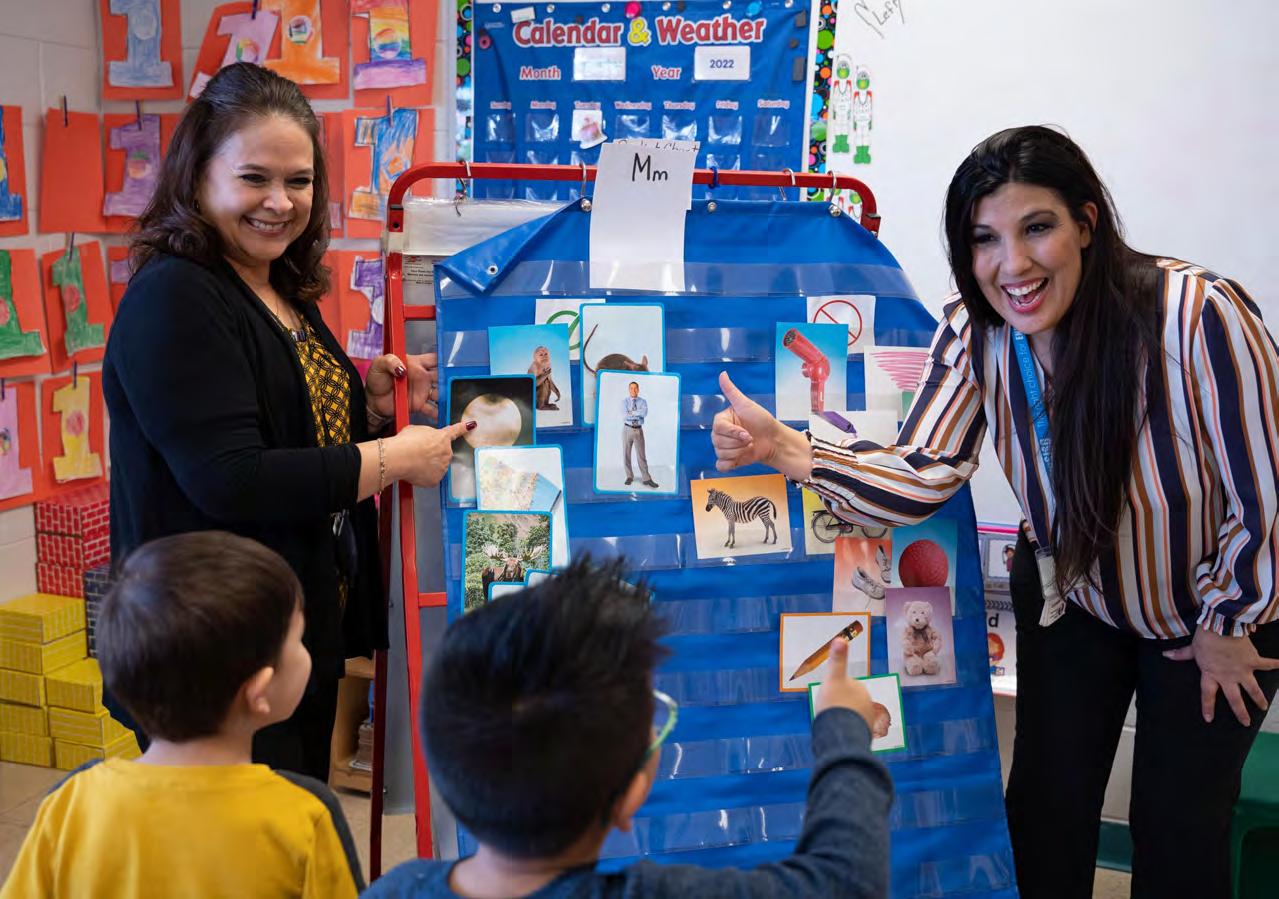
44 BRAGGING RIGHTS 2022-2023 Texas School Business
program creates pipeline of well-trained teachers in Socorro ISD
Residency
▲ In Socorro ISD, a teacher residency program provides on-the-job training for new teachers. SOCORRO ISD Socorro ISD County: El Paso Region: 19 Superintendent: Nate Carman 2020 enrollment: 47,397 Number of schools: 51
and principals involved, and the district as a whole. Here’s how it works: During their last year of UTEP’s four-year teacher training program, student residents spend three days a week for an entire school year, either fall to spring or spring to fall, each working in an assigned classroom alongside a carefully chosen mentor teacher. On Wednesdays, they attend classes at UTEP. On Fridays, they serve as a substitute teacher somewhere on their assigned campuses.
And unlike in traditional student teaching, student residents get paid — a minimum of $20,000 for the school year. In fall 2022, the program welcomed 35 residents between eight district campuses, and 163 have come through the program since its inception.
“Just like doctors go through a paid residency in order to move up in their careers, the same should be true of teachers,” says Jina Eksaengsri, the district’s school improvement officer, who runs the program’s day-to-day operations.
The Teacher Residency Program began because SISD Chief Academic Officer Lucia Borrego felt that first-year teachers were underprepared for their role. Over the summer in 2019, not long after taking on her position with the district, Borrego was at UTEP for an unrelated meeting when she happened to spot the dean of the college of education, who was also new to his position at the time.
“I wasn’t there, but I like to visualize her fighting through the crowd to get to the dean, and approaching him — yeah, I’m pretty sure that’s how it went,” jokes Eksaengsri, “— and going up to him and saying, ‘Hey, we have to do something different about student teaching.’ And that kind of springboarded this entire project.”
By the start of the school year, a pilot program of six teacher residents had been established in one of SISD’s elementary schools.

For the district, the goal of the program is to create a pipeline of well-trained teachers. Since the program’s inception, the rate of teacher residents who stay with the district after graduation has grown. Now, the district is aiming for 100% retention by asking prospective participants to sign a three-year commitment, including their residency year, before becoming a resident.
Not only do teacher residents gain an understanding of SISD’s practices around lesson plans, PLCs, student discipline and district culture, they have a distinct leg up when it comes to getting hired. Though they still have to apply and interview for teaching positions, principals are eager to hire them, and they even get a separate job fair.
“They get first dibs,” says Borrego. “Our principals get first dibs to them and they get first dibs to us.”
The program is so groundbreaking that Region 13 created videos about it that are now in the TEA library as part of the Effective Schools Framework.
Initially, the program was funded by US Prep, which had already planned to do a study with UTEP, and local philanthropists.
More recently, the district received a Texas COVID Learning Acceleration Supports (TCLAS) grant, and SISD Superintendent Dr. Nate Carman has committed district funding as well. This has allowed the program to double the number of residents they can accept.
45 BRAGGING RIGHTS 2022-2023 Texas School Business
▲ In Socorro ISD, student residents in their final year of student teaching spend three days a week working in an assigned classsroom alongside a mentor teacher.
▲ The teacher residency program in SISD provides exceptional support to student teachers, who continue to receive that support for two years following their residencies.

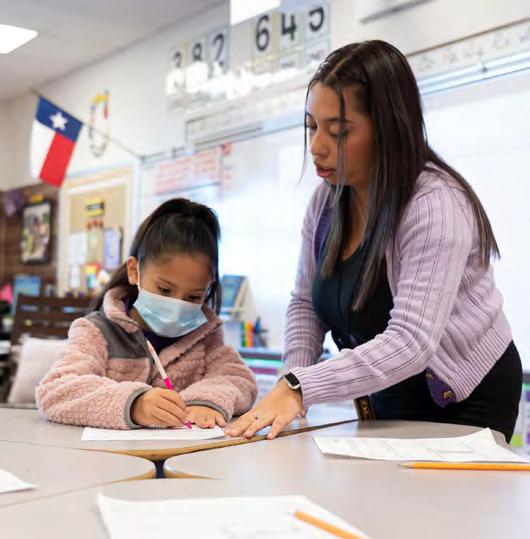
For Carman, backing the program with district funds comes down to three things: First, it solves the problem of too few substitute teachers. Second, it gives the residents real-world experience managing a classroom on their own. Third, it gives them the opportunity to work with students in more age groups.
“They might want to be a second grade teacher, but if we put them as a substitute into a pre-K or a fifth grade classroom, it opens their eyes up a little bit,” says Carman. “Either they may find a new passion, or that may really, really reinforce that they want to be in second grade.”
One aspect that sets the program apart is the level of support provided. Yvonne Romero, the district’s coordinator of cultural opportunity, checks in with residents during their substituting duties on Fridays, and works with them to make sure they’re workforce ready, helping polish résumés, practicing interview questions, and coaching them in professional soft skills. Residents continue to get support for two additional years beyond their residency.
The residents aren’t the only ones learning, either.
“Not only are [the mentor teachers] teaching them, but they’re learning from the residents as well,” says Romero. “They’re keeping up and they’re keeping them on their toes.”
SISD and UTEP hold governance meetings for the program at least four times a year. There, district and university personnel come together, including the college dean, the superintendent of schools, site coordinators, and principals from participating schools, to look at data and discuss residents’ performance in the classrooms. They make adjustments to the program — and, according to Borrego, administrators’ willingness to learn from failures is one of the major strengths of the program.
Lisa Alarcon is a teacher resident who will be graduating from UTEP in December. For her, there’s no doubt the Teacher Residency Program is a step up from traditional student teaching.
“It helps me prepare to be a teacher from day one,” says Alarcon. “It’s helping me grow. I’m learning lesson plans, I’m doing staff development, PLCs, participating with my mentor teacher and the grade level team to do so much. I absolutely love this program.”
Best of all, the program’s ripple effects will extend well beyond those who are directly involved.
“There’s going to be a lot of kids who are going to make this world
better place because Lisa’s a teacher,” says Borrego. “And we’ve
46 BRAGGING RIGHTS 2022-2023 Texas School Business
Yvonne Romero, the district’s coordinator of cultural opportunity, checks in with residents during their substituting duties on Fridays, and works with them to make sure they’re workforce ready, helping polish résumés, practicing interview questions, and coaching them in professional soft skills.
a
prepared her for that.”
Leila Kalmbach is a freelance writer and self-employment coach for freelancers.
SPLENDORA ISD Splendora ISD
Splendora ISD’s success is more than test grades
by Autumn Rhea Carpenter
School districts, like its students, need creative ways to share their unique stories.
In 2017, Splendora ISD decided it was time to give the community a broader picture of their district that showcased how they were doing beyond an A-F rating.
SISD joined the Texas Public Accountability Consortium (TPAC), a group of more than 30 public school districts across the state that met to build a well-crafted community-based accountability system (CBAS). The group was designed to communicate the quality effort made by a school and district other than the state’s standardized, test-centric accountability system, which members believe fails to provide a full
picture of what is taking place in a school.
In 2018, SISD created the Realtor and Developer Lunch and Learn, an annual event where the district shares current topics with local realtors to present a more holistic view of the schools, rather than a simple letter rating.

Each June, SISD discusses hot topics including elementary school zones, school safety and new housing developments. They provide the latest demographic studies, district goals and other operational information. The realtors ask questions, and no topic is off limits.
The luncheon’s presentation specifically highlights components of the localized accountability system, including:
47 BRAGGING RIGHTS 2022-2023 Texas School Business
▲ Splendora ISD Superintendent Jeff Burke speaks with Realtor Stephanie Denman about the district’s many successes.
County: Montgomery Region: 6 Superintendent: Jeff Burke 2020 enrollment: 4,155 Number of schools: 6
• Student learning and progress: Ensure academic success for all students, including English-language learners, special education students, recent immigrants, gifted and talented students, and students with emotional and behavioral issues.
• Student readiness: Ensure students are well prepared for their next level of education and for post-secondary success, including career readiness, college readiness and military readiness.

• Engaged, well-rounded students: Engage students in a way that contributes to their overall development and future wellbeing.
• Community engagement and partnerships: Ensure that local citizens are a meaningful, integral part of a CBAS and can and will support their local public schools.
• Professional learning and quality staff: Ensure that every student has quality teachers and adults in the schools that care about students, their learning, and their well-being.
• Fiscal and operational systems: Ensure the district is using its resources to further its mission to educate the students it is assigned to serve.
• Safety and well-being: Ensure students are educated in an optimal environment that is safe, secure and conducive to learning. This includes both physical safety as well as the social and emotional needs of each student.
• District rating: B+ since 2019
“These meetings provide a more personal experience,” says Jeff Burke, SISD superintendent. “The goal is for the realtors
to share all the great things happening in Splendora ISD with potential homeowners and know that our district is more than a ‘B.’”
Luncheon participants learn specific details about each school year. For example, in 2021-22, the district shared:
• Child Nutrition served 795,979 meals including 296,583 breakfasts and 499,396 lunches.
• 10,882 maintenance work orders were completed.
• The transportation department drove 527,427 miles with 63 bus routes.
• Custodial services cleaned 877,308 square feet daily. The luncheon began with only real estate agents in attendance, but now includes other branches of the industry, such as builders, title agents, insurance agents and developers.
“We also send an open invitation to all parents, community members, and businesses,” says Burke. “Everyone knows a realtor, and they share or tag them. Once realtors sign up, we personally invite them each year.”
Stephanie Denman of Styled Real Estate has attended the event since its inception.
“The program helps agents better educate new homeowners in the area with upcoming tax information, area growth, new school development, bond election information, and how schools are integrating new programs,” she says. “It provides me information that I might not have known of otherwise. I have always appreciated that SISD doesn’t laser focus on standardized testing scores as a true marker of success, but as a secondary tool. They
48 BRAGGING RIGHTS 2022-2023 Texas School Business
▲ Superintendent Burke addresses real estate agents at the district’s annual Lunch and Learn event.
▲ The purpose of Lunch and Learn events is to keep community members informed of the outstanding things happening in SISD.
truly care about building relationships.”
Splendora ISD is a direct reflection of the community and area where Angie Angers, a realtor at the Covenant Realty Group, works as a real estate agent.

“I have to be knowledgeable about the schools in order to help my clients,” she says. “When a school district is easy to contact, recognizes that real estate agents are important in the community, and the leaders in the district are open and communicative, this makes the relationship successful.”
The Lunch and Learn also offer realtors an opportunity to understand how the community is changing.
“The school is always made aware of resident growth, commercial business coming in, and housing development growth,” says Angers. “This is incredible knowledge for a real estate agent to not only receive but to share.”
In 2018, the Splendora Education Foundation launched to provide funding for innovation in the classroom. They have provided food at the luncheons the past two years.
“The SISD Education Foundation has impacted the community by allowing community members to be involved directly in building up the school district and helping give back to the school and the teachers by providing grants through fundraisers,” says Angers. “It is a positive addition and once again promotes unity throughout our community by having a common goal.”
For districts interested in launching a similar Lunch and Learn program, Burke recommends inclusivity.
“These realtor luncheons are a great place to start. I recommend including developers in the conversation and invite all realtors in the area. We haven’t seen any issues as a result of this endeavor.”
Denman says Burke’s dedication to inclusion is the secret to the Realtor and Developer Lunch and Learn’s success.
“I have seen a few different superintendents throughout the years of Splendora ISD and I believe Dr. Burke has been extraordinary in community involvement as well as educating parents, neighbors, staff and local business on the status of Splendora ISD
In 2018, SISD created the Realtor and Developer Lunch and Learn, an annual event where the district shares current topics with local realtors to present a more holistic view of the schools, rather than a simple letter rating.
and the changes forthcoming.”
When school districts implement creative strategies and include the entire community, everyone wins.
“Connection and transparency are a big deal,” Angers says. “The community likes to see the tax dollars at work and wants to be informed on how it is working in positive ways. The school district’s willingness to showcase that is huge and creates trust and partnerships.”
Autumn Rhea Carpenter is a freelance journalist based in Portland, Oregon.
49 BRAGGING RIGHTS 2022-2023 Texas School Business
Join Us!

TASA is the professional association for Texas school leaders. In addition to advocacy and professional learning, we provide networks and services that offer mentorship and inspiration to our members. TASA is working hard to provide the support that Texas school leaders need. We invite you to be part of TASA! Join today for the 2022-23 membership year!

tasanet.org




 DACIA RIVERS Editorial Director
DACIA RIVERS Editorial Director



































 by Leila Kalmbach
by Leila Kalmbach






















 by Stacy Alexander Evans
by Stacy Alexander Evans



















